| Revision as of 21:46, 17 February 2016 view sourceONUnicorn (talk | contribs)Administrators19,805 edits →Varieties: link to list article← Previous edit | Revision as of 09:36, 29 March 2016 view source Cyberbot II (talk | contribs)Bots, Pending changes reviewers469,527 edits Rescuing 1 sources. #IABotNext edit → | ||
| Line 32: | Line 32: | ||
| , 2004, Rolf C. Hagen, Inc. (USA) and Rolf C. Hagen Corp. (Montreal, Canada)</ref> | , 2004, Rolf C. Hagen, Inc. (USA) and Rolf C. Hagen Corp. (Montreal, Canada)</ref> | ||
| By the ] (960–1279), the domestication of goldfish was firmly established.<ref name=smartt>{{cite book|last=Smartt|first=Joseph|title=Goldfish varieties and genetics: A handbook for breeders|year=2001|publisher=Blackwell Science|location=Oxford|isbn=978-0-85238-265-3|page=21}}</ref> In 1162, the ] of the ] ordered the construction of a pond to collect the red and gold variety. By this time, people outside the imperial family were forbidden to keep goldfish of the gold (yellow) variety, ]. This is probably the reason why there are more orange goldfish than yellow goldfish, even though the latter are genetically easier to breed.<ref>{{cite web |
By the ] (960–1279), the domestication of goldfish was firmly established.<ref name=smartt>{{cite book|last=Smartt|first=Joseph|title=Goldfish varieties and genetics: A handbook for breeders|year=2001|publisher=Blackwell Science|location=Oxford|isbn=978-0-85238-265-3|page=21}}</ref> In 1162, the ] of the ] ordered the construction of a pond to collect the red and gold variety. By this time, people outside the imperial family were forbidden to keep goldfish of the gold (yellow) variety, ]. This is probably the reason why there are more orange goldfish than yellow goldfish, even though the latter are genetically easier to breed.<ref>{{cite web|url=http://www.wetpetz.com/goldfish.htm |title=goldfish |accessdate=2013-02-28 |deadurl=yes |archiveurl=https://web.archive.org/web/20090901050610/http://www.wetpetz.com/goldfish.htm |archivedate=September 1, 2009 }}</ref> The occurrence of other colours (apart from red and gold) was first recorded in 1276.{{citation needed|date=August 2015}} | ||
| ]]] | ]]] | ||
Revision as of 09:36, 29 March 2016
This article is about the ornamental fish. For other uses, see Goldfish (disambiguation).
| Goldfish | |
|---|---|
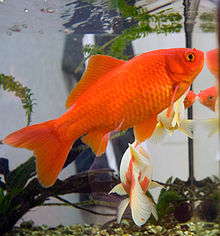
| |
| Conservation status | |
| Domesticated | |
| Scientific classification | |
| Kingdom: | Animalia |
| Phylum: | Chordata |
| Class: | Actinopterygii |
| Order: | Cypriniformes |
| Family: | Cyprinidae |
| Genus: | Carassius |
| Species: | C. auratus (Linnaeus, 1758) |
The goldfish (Carassius auratus) is a freshwater fish in the family Cyprinidae of order Cypriniformes. It was one of the earliest fish to be domesticated, and is one of the most commonly kept aquarium fish.
A relatively small member of the carp family (which also includes the koi carp and the crucian carp), the goldfish is a domesticated version of a less-colourful carp (Carassius auratus) native to east Asia. It was first domesticated in China more than a thousand years ago, and several distinct breeds have since been developed. Goldfish breeds vary greatly in size, body shape, fin configuration and colouration (various combinations of white, yellow, orange, red, brown, and black are known).
The mutation that gave rise to the domestic goldfish is also known from other cyprinid species, such as common carp and tench.
History

Starting in ancient China, various species of carp (collectively known as Asian carp) have been domesticated and reared as food fish for thousands of years. Some of these normally gray or silver species have a tendency to produce red, orange or yellow colour mutations; this was first recorded during the Jin dynasty (265–420).

During the Tang dynasty (618–907), it was popular to raise carp in ornamental ponds and watergardens. A natural genetic mutation produced gold (actually yellowish orange) rather than silver colouration. People began to breed the gold variety instead of the silver variety, keeping them in ponds or other bodies of water. On special occasions at which guests were expected they would be moved to a much smaller container for display.
By the Song dynasty (960–1279), the domestication of goldfish was firmly established. In 1162, the empress of the Song Dynasty ordered the construction of a pond to collect the red and gold variety. By this time, people outside the imperial family were forbidden to keep goldfish of the gold (yellow) variety, yellow being the imperial colour. This is probably the reason why there are more orange goldfish than yellow goldfish, even though the latter are genetically easier to breed. The occurrence of other colours (apart from red and gold) was first recorded in 1276.
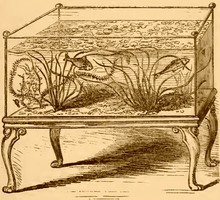
During the Ming dynasty (1368–1644), goldfish also began to be raised indoors, which permitted selection for mutations that would not be able to survive in ponds. The first occurrence of fancy-tailed goldfish was recorded in the Ming Dynasty. In 1603, goldfish were introduced to Japan. In 1611, goldfish were introduced to Portugal and from there to other parts of Europe.
During the 1620s, goldfish were highly regarded in southern Europe because of their metallic scales, and symbolised good luck and fortune. It became tradition for married men to give their wives a goldfish on their one-year anniversary, as a symbol for the prosperous years to come. This tradition quickly died, as goldfish became more available, losing their status. Goldfish were first introduced to North America around 1850 and quickly became popular in the United States.
Classification
Varieties
Main article: List of goldfish varietiesSelective breeding over centuries has produced several colour variations, some of them far removed from the "golden" colour of the originally domesticated fish. There are also different body shapes, fin and eye configurations. Some extreme versions of the goldfish live only in aquariums—they are much less hardy than varieties closer to the "wild" original. However, some variations are hardier, such as the Shubunkin. Currently, there are about 300 breeds recognised in China. The vast majority of goldfish breeds today originated from China. Some of the main varieties are:
| Common goldfish | Black Telescope | Bubble Eye | |||
|---|---|---|---|---|---|
| Common goldfish differ only in colour from their closest relative, the Prussian carp. Common goldfish come in a variety of colours including red, orange/gold, white, black and yellow or 'lemon' goldfish. | 
|
The Black telescope is a black variant of telescope goldfish that has a characteristic pair of protruding eyes. It is also referred to as popeye, telescope, kuro demekin in Japan and dragon-eye in China. | 
|
The small, fancy Bubble Eye has upward pointing eyes accompanied by two large fluid-filled sacs. | 
|
| Celestial Eye | Comet | Fantail | |||
| Fancy Celestial eye goldfish or Choten gan has a double tail and a breed-defining pair of upturned, telescope eyes with pupils gazing skyward. | 
|
The comet or comet-tailed goldfish is the most common fancy variety in the United States. It is similar to the common goldfish, except slightly smaller and slimmer, and is mainly distinguished by its long, deeply forked tail. | 
|
The Fantail goldfish is the western form of the Ryukin and possesses an egg-shaped body, a high dorsal fin, a long quadruple caudal fin, and no shoulder hump. | 
|
| Lionhead | Oranda | Pearlscale | |||
| The fancy lionhead has a hood. This fish is the precursor to the ranchu. | 
|
The fancy oranda is characterised by a prominent raspberry-like hood (also known as wen or headgrowth) that encases the whole head except for the eyes and mouth. | 
|
The fancy pearlscale or chinshurin in Japanese, is spherical-bodied with finnage similar to the fantail. | 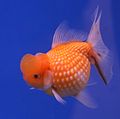
|
| Pompom | Ryukin | Shubunkin | |||
| The fancy Pompoms or pompon or hana fusa have bundles of loose fleshy outgrowths between the nostrils, on each side of the head. | 
|
The fancy ryukin has a short, deep body with a characteristic shoulder hump. | 
|
Fancy and hardy Japanese Shubunkins (朱文金) (translated literally as "red brocade") have a single tail with nacreous scales, and a pattern known as calico. | 
|
| Telescope | Ranchu | Panda Telescope | |||
| The fancy telescope is characterised by its protruding eyes. It is also known as globe eye or dragon eye goldfish. | 
|
The fancy Japanese ranchu is hooded. The Japanese refer to it as the "king of goldfish". | 
|
The fancy panda telescope is a panda variant of telescope goldfish. | 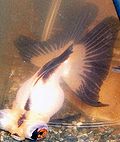
|
| Veiltail | Butterfly tail | Meteor goldfish | |||
| The fancy veiltail is known for its extra-long, flowing double tail. Modern veiltail standards require little or no indentation of the trailing edges of the caudal fins, as in a wedding veil for a bride. | 
|
The Butterfly Tail Moor or Butterfly Telescope is of the telescope-eye lineage, with twin tails best viewed from above. The spread of the caudal fins resembles butterflies underwater. | 
|
The Meteor goldfish is a strange-looking variety that has been developed by specialist breeders of fancy goldfish. It has no tail fin, hence its name. | |
| Lionchu | Egg-fish goldfish | Shukin | |||
| The Lionchu or lionhead-ranchu is a fancy goldfish that has resulted from crossbreeding lionheads and ranchus. | 
|
The egg-fish goldfish is a fancy goldfish that lacks a dorsal fin and has a pronounced egg-shaped body. | 
|
The Shukin is Ranchu-like goldfish developed from Ranchu and Oranda at the end of the 19th century in Japan. | |
| Curled-gill goldfish | Tamasaba | Tosakin | |||
| The Curled-gill or Reversed-gill goldfish is another uncommon variety of fancy goldfish that has been developed by specialist enthusiasts. It owes its name to the out-turned appearance of its gill covers. | 
|
The Tamasaba or Sabao is an uncommon Japanese variety of goldfish with a body shaped similar to the Ryukin and a very long, flowing, single tail that is similar to that of a mackerel, hence its other name, Mackerel Tail. | 
|
The Tosakin or curly fantail goldfish is a very distinctive breed of goldfish with a large tail fin that spreads out horizontally (like a fan) behind the fish. Though technically a divided tail, the two halves are attached at the center/middle forming a single fin. | 
|
| White Telescope | |||||
| The White telescope is a white variant of telescope goldfish that has a white body and characteristic pair of protruding eyes. | |||||
Chinese goldfish classification
Chinese tradition classifies goldfish into four main types. These classifications are not commonly used in the West.
- Crucian (may also be called "grass")—Goldfish without fancy anatomical features. These include the common goldfish, comet goldfish and Shubunkin.
- Wen—Goldfish have a fancy tail, e.g., Fantails and Veiltails ("Wen" is also the name of the characteristic headgrowth on such strains as Oranda and Lionhead)
- Dragon Eye—Goldfish have extended eyes, e.g., Black Moor, Bubble Eye, and Telescope Eye
- Egg—Goldfish have no dorsal fin, and usually have an 'egg-shaped' body, e.g., Lionhead (note that a Bubble Eye without a dorsal fin belongs to this group)
Related species


Goldfish were bred from Prussian carp (Carassius auratus gibelio) in China, and these usually olive green fsh remain the closest wild relative of the goldfish. Previously, some sources claimed the Crucian carp (Carassius carassius) as the wild version of the goldfish. However, they are differentiated by several characteristics. C. auratus have a more pointed snout while the snout of a C. carassius is well rounded. C. a. gibelio often has a grey/greenish colour, while crucian carp are always golden bronze. Juvenile crucian carp have a black spot on the base of the tail which disappears with age. In C. auratus this tail spot is never present. C. auratus have fewer than 31 scales along the lateral line while crucian carp have 33 scales or more.
Like their wild ancestors, common and comet goldfish as well as Shubunkin can survive, and even thrive, in any climate that can support a pond, whereas fancy goldfish are unlikely to survive in the wild as their bright colours and long fins make them easy prey. Goldfish can hybridise with certain other species of carp as well as C. a. gibelio. Within three breeding generations, the vast majority of the hybrid spawn revert to the wild type colour. Koi may also interbreed with the goldfish to produce sterile hybrids.
Biology
Size
As of April 2008, the largest goldfish in the world was believed by the BBC to measure 19 inches (48 cm), and be living in the Netherlands. At the time, a goldfish named "Goldie", kept as a pet in a tank in Folkestone, England, was measured as 15 inches (38 cm) and over 2 pounds (0.91 kg), and named as the second largest in the world behind the Netherlands fish. The secretary of the Federation of British Aquatic Societies (FBAS) stated of Goldie's size that "I would think there are probably a few bigger goldfish that people don't think of as record holders, perhaps in ornamental lakes". In July 2010, a goldfish measuring 16 inches (41 cm) and 5 pounds (2.3 kg) was caught in a pond in Poole, England, thought to have been abandoned there after outgrowing a tank.
Vision

Goldfish have one of the most studied senses of vision in fishes. Goldfish have four kinds of cone cells, which are respectively sensitive to different colours: red, green, blue and ultraviolet. The ability to distinguish between four different primary colours classifies them as tetrachromats.
Cognitive abilities
Goldfish have strong associative learning abilities, as well as social learning skills. In addition, their visual acuity allows them to distinguish between individual humans. Owners may notice that fish react favorably to them (swimming to the front of the glass, swimming rapidly around the tank, and going to the surface mouthing for food) while hiding when other people approach the tank. Over time, goldfish learn to associate their owners and other humans with food, often "begging" for food whenever their owners approach.
Goldfish that have constant visual contact with humans also stop considering them to be a threat. After being kept in a tank for several weeks, sometimes months, it becomes possible to feed a goldfish by hand without it shying away.
Goldfish have a memory-span of at least three months and can distinguish between different shapes, colours and sounds. By using positive reinforcement, goldfish can be trained to recognise and to react to light signals of different colours or to perform tricks. Fish respond to certain colours most evidently in relation to feeding. Fish learn to anticipate feedings provided they occur at around the same time every day.
Behaviour
Goldfish are gregarious, displaying schooling behaviour, as well as displaying the same types of feeding behaviours. Goldfish may display similar behaviours when responding to their reflections in a mirror.
Goldfish have learned behaviours, both as groups and as individuals, that stem from native carp behaviour. They are a generalist species with varied feeding, breeding, and predator avoidance behaviours that contribute to their success. As fish they can be described as "friendly" towards each other. Very rarely does a goldfish harm another goldfish, nor do the males harm the females during breeding. The only real threat that goldfish present to each other is competing for food. Commons, comets, and other faster varieties can easily eat all the food during a feeding before fancy varieties can reach it. This can lead to stunted growth or possible starvation of fancier varieties when they are kept in a pond with their single-tailed brethren. As a result, care should be taken to combine only breeds with similar body type and swim characteristics.
Feeding

In the wild, the diet of goldfish consists of crustaceans, insects, and various plant matter. Like most fish, they are opportunistic feeders and do not stop eating on their own accord. Overfeeding can be deleterious to their health, typically by blocking the intestines. This happens most often with selectively bred goldfish, which have a convoluted intestinal tract. When excess food is available, they produce more waste and faeces, partly due to incomplete protein digestion. Overfeeding can sometimes be diagnosed by observing faeces trailing from the fish's cloaca.
Goldfish-specific food has less protein and more carbohydrate than conventional fish food. Enthusiasts may supplement this diet with shelled peas (with outer skins removed), blanched green leafy vegetables, and bloodworms. Young goldfish benefit from the addition of brine shrimp to their diet. As with all animals, goldfish preferences vary.
Reproduction
Goldfish may only grow to sexual maturity with enough water and the right nutrition. Most goldfish breed in captivity, particularly in pond settings. Breeding usually happens after a significant temperature change, often in spring. Males chase gravid female goldfish (females carrying eggs), and prompt them to release their eggs by bumping and nudging them.
Goldfish, like all cyprinids, are egg-layers. Their eggs are adhesive and attach to aquatic vegetation, typically dense plants such as Cabomba or Elodea or a spawning mop. The eggs hatch within 48 to 72 hours.
Within a week or so, the fry begins to assume its final shape, although a year may pass before they develop a mature goldfish colour; until then they are a metallic brown like their wild ancestors. In their first weeks of life, the fry grow quickly—an adaptation born of the high risk of getting devoured by the adult goldfish (or other fish and insects) in their environment. Pregnant goldfish are called twit.
Some highly bred goldfish can no longer breed naturally due to their altered shape. The artificial breeding method called "hand stripping" can assist nature, but can harm the fish if not done correctly. In captivity, adults may also eat young that they encounter.
 |
 |
Cultivation
In aquaria
Like most species in the carp family, goldfish produce a large amount of waste both in their faeces and through their gills, releasing harmful chemicals into the water. Build-up of this waste to toxic levels can occur in a relatively short period of time, and can easily cause a goldfish's death. For common and comet varieties, each goldfish should have about 20 US gallons (76 L; 17 imp gal) of water. Fancy goldfish (which are smaller) should have about 10 US gallons (38 L; 8.3 imp gal) per goldfish. The water surface area determines how much oxygen diffuses and dissolves into the water. A general rule is have 1 square foot (0.093 m). Active aeration by way of a water pump, filter or fountain effectively increases the surface area.
The goldfish is classified as a coldwater fish, and can live in unheated aquaria at a temperature comfortable for humans. However, rapid changes in temperature (for example in an office building in winter when the heat is turned off at night) can kill them, especially if the tank is small. Care must also be taken when adding water, as the new water may be of a different temperature. Temperatures under about 10 °C (50 °F) are dangerous to fancy varieties, though commons and comets can survive slightly lower temperatures. Extremely high temperatures (over 30 °C (86 °F) can also harm goldfish. However, higher temperatures may help fight protozoan infestations by accelerating the parasite's life-cycle—thus eliminating it more quickly. The optimum temperature for goldfish is between 20 °C (68 °F) and 22 °C (72 °F).
Like all fish, goldfish do not like to be petted. In fact, touching a goldfish can endanger its health, because it can cause the protective slime coat to be damaged or removed, exposing the fish’s skin to infection from bacteria or water-born parasites. However, goldfish respond to people by surfacing at feeding time, and can be trained or acclimated to taking pellets or flakes from human fingers. The reputation of goldfish dying quickly is often due to poor care. The lifespan of goldfish in captivity can extend beyond 10 years.
If left in the dark for a period of time, goldfish gradually change colour until they are almost gray. Goldfish produce pigment in response to light, in a similar manner to how human skin becomes tanned in the sun. Fish have cells called chromatophores that produce pigments which reflect light, and give the fish colouration. The colour of a goldfish is determined by which pigments are in the cells, how many pigment molecules there are, and whether the pigment is grouped inside the cell or is spaced throughout the cytoplasm.
Because goldfish eat live plants, their presence in a planted aquarium can be problematic. Only a few aquarium plant species for example Cryptocoryne and Anubias, can survive around goldfish, but they require special attention so that they are not uprooted. Plastic plants are more durable.
In ponds
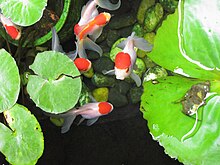
Goldfish are popular pond fish, since they are small, inexpensive, colourful and very hardy. In an outdoor pond or water garden, they may even survive for brief periods if ice forms on the surface, as long as there is enough oxygen remaining in the water and the pond does not freeze solid. Common goldfish, London and Bristol shubunkins, jikin, wakin, comet and some hardier fantail goldfish can be kept in a pond all year round in temperate and subtropical climates. Moor, veiltail, oranda and lionhead can be kept safely in outdoor ponds year-round only in more tropical climates and only in summer elsewhere.
Ponds small and large are fine in warmer areas (although it ought to be noted that goldfish can "overheat" in small volumes of water in summer in tropical climates). In frosty climes the depth should be at least 80 centimeters (31 in) to preclude freezing. During winter, goldfish become sluggish, stop eating and often stay on the bottom of the pond. This is normal; they become active again in the spring. Unless the pond is large enough to maintain its own ecosystem without interference from humans, a filter is important to clear waste and keep the pond clean. Plants are essential as they act as part of the filtration system, as well as a food source for the fish. Plants are further beneficial since they raise oxygen levels in the water.
Compatible fish include rudd, tench, orfe and koi, but the latter require specialised care. Ramshorn snails are helpful by eating any algae that grows in the pond. Without some form of animal population control, goldfish ponds can easily become overstocked. Fish such as orfe consume goldfish eggs.
For mosquito control
Like some other popular aquarium fish, such as the guppy, goldfish and other carp are frequently added to stagnant bodies of water to reduce mosquito populations. They are used to prevent the spread of West Nile Virus, which relies on mosquitoes to migrate. However, introducing goldfish has often had negative consequences for local ecosystems.
Welfare concerns
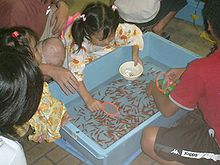
Some countries ban the sale of traditional fishbowls under animal welfare legislation due to the risk of stunting, deoxygenation and ammonia/nitrite poisoning in such a small environment. Because of their large oxygen needs and high waste output, such bowls are no longer considered appropriate housing for goldfish.
In many countries, carnival and fair operators commonly give goldfish away in plastic bags as prizes. In late 2005 Rome banned the use of goldfish and other animals as carnival prizes. Rome has also banned the use of "goldfish bowls", on animal cruelty grounds, as well as Monza, Italy, in 2004. In the United Kingdom, the government proposed banning this practice as part of its Animal Welfare Bill, though this has since been amended to only prevent goldfish being given as prizes to unaccompanied minors.
In Japan, during summer festivals and religious holidays (ennichi), a traditional game called goldfish scooping is played, in which a player scoops goldfish from a basin with a special scooper. Sometimes bouncy balls are substituted for goldfish.
Although edible and closely related to some fairly widely eaten species, goldfish are rarely eaten. A fad among American college students for many years was swallowing goldfish as a stunt and as a fraternity initiation process. The first recorded instance was in 1939 at Harvard University. The practice gradually fell out of popularity over the course of several decades and is rarely practiced today.
In Iran and among the international Iranian diaspora, goldfish are a traditional part of Nowruz celebrations. Some animal advocates have called for boycotts of goldfish purchases, citing industrial farming and low survival rates of the fish.
See also
Notes and references
- "USGS-NAS, Non-indigenous Aquatic Species". Retrieved 2015-04-29.
- "Carassius auratus (Linnaeus, 1758)". Fishbase. Retrieved 2015-04-29.
- "Goldfish". Ocean Park. Retrieved 2009-11-16.
- ^ Roots, Clive (2007). Domestication. Westport: Greenwood Press. pp. 20–21. ISBN 978-0-313-33987-5.
- ^ "Background information about goldfish". Bristol Aquarists' Society. Retrieved 2006-07-28.
- Nutrafin Aquatic News, Issue #4, 2004, Rolf C. Hagen, Inc. (USA) and Rolf C. Hagen Corp. (Montreal, Canada)
- Smartt, Joseph (2001). Goldfish varieties and genetics: A handbook for breeders. Oxford: Blackwell Science. p. 21. ISBN 978-0-85238-265-3.
- "goldfish". Archived from the original on September 1, 2009. Retrieved 2013-02-28.
{{cite web}}: Unknown parameter|deadurl=ignored (|url-status=suggested) (help) - Brunner, Bernd (2003). The Ocean at Home. New York: Princeton Architectural Press. ISBN 1-56898-502-9.
- Mulertt, Hugo (1883). The Goldfish And Its Systematic Culture With A View To Profit. Retrieved 2009-07-07.
- Fancy Goldfish Varieties, Bristol Aquarists' Society, Bristol-Aquarists.org, retrieved on: June 20, 2007
- ^ Andrews, Dr. Chris. "An Interpet Guide to Fancy Goldfish", Interpet Publishing, 2002 - ISBN 1-902389-64-6
- "What is a Lionchu?" by Peter Ponzio, an article from the Goldfish Pages Website (Goldfish Society of America), date retrieved: 28 February 2013
- "GFSA - Ask the Judges", an article about the Lionchu by Larry Christensen, Peter Ponzio, Scott Taylor, Tony Reynolds and John Parker, from the Goldfish Pages Website (Goldfish Society of America), date retrieved: 28 February 2013
- Andrews, Chris, Dr. An Interpet Guide to Fancy Goldfish, Interpet Publishing, 2002. - ISBN 1-902389-64-6
- "Nutrafin Aquatic News, Issue #4, 2004, Rolf C. Hagen, Inc. (USA) and Rolf C. Hagen Corp. (Montreal, Canada)". Hagen.com. Retrieved 2011-11-19.
- Johnson, Dr. Erik L., D.V.M. and Richard E. Hess. Fancy Goldfish: A Complete Guide to Care and Collecting, Shambhala Publications, Inc., 2001 - ISBN 0-8348-0448-4
- http://www.cnaquafish.com/html_news/QiYeXinWenTest-2-3.html
- Komiyama, Tomoyoshi; Hiroyuki Kobayashi; Yoshio Tateno; Hidetoshi Inoko; Takashi Gojobori; Kazuho Ikeo (February 2009). "An evolutionary origin and selection process of goldfish". Gene. 430 (1–2): 5–11. doi:10.1016/j.gene.2008.10.019. PMID 19027055. Retrieved 2010-08-09.
- Les Pearce. "Common Gold Fish". Aquarticles. Retrieved 20 June 2006.
- ^ "Giant goldfish 'simply amazing'". BBC News. 17 April 2008. Retrieved 17 July 2010.
- "Surrey schoolboy catches 5lb goldfish in Dorset lake". BBC News. 15 July 2010. Retrieved 17 July 2010.
- Neumeyer, C. (2003). "Color Vision in Fishes and Its Neural Basis". In Collin, S.P. and Marshall, N.J. (ed.). Sensory Processing in Aquatic Environments. New York: Springer-Verlag. p. 223.
In goldfish, as the best investigated fish species
{{cite book}}: CS1 maint: multiple names: editors list (link) - Neumeyer, Christa (1988). Das Farbensehen des Goldfisches: Eine verhaltensphysiologische Analyse. G. Thieme. ISBN 313718701X.
- Research by the School of Psychology at the University of Plymouth in 2003. Goldfish were trained to push a lever to earn a food reward; when the lever was fixed to work only for an hour a day, the fish soon learned to activate it at the correct time.
- The Discovery Channel's show Mythbusters tested the contemporary legend that goldfish only had a memory span of 3 seconds and were able to prove that goldfish had a longer memory span than commonly believed. The experiment involved training the fish to navigate a maze. It was evident that they were able to remember the correct path of the maze after more than a month. Mythbuster Results: A goldfish’s memory lasts only three seconds
- Demonstrated in a 1994 public experiment at the Palais de la Découverte science museum. The experimental details and results are described in: "Poissons rouges: la mémoire dans l'eau". Revue du Palais de la découverte. 217. April 1994.
- "Send Your Fish to School". ABC News. May 7, 2008. Retrieved December 28, 2012.
- Loh, Richmond. "Goldfish (Carassius auratus)" (PDF). The Fish Vet.com. Retrieved December 31, 2013.
- "trivia". seaver-faculty.pepperdine.edu.
- "Goldfish". Mypets.net.au. Retrieved 2011-11-19.
- "Goldfish". Experiencefestival.com. Retrieved 2011-11-19.
- http://www.bbc.com/news/29210991
- William L. Arnold; William L. Anderson (2001). Biotechnology Deskbook. Environmental Law Institute. p. 154. ISBN 1-58576-029-3.
- "5 reasons not to use goldfish bowls". Goldfish Care Guide. 2008-03-05. Retrieved 2009-02-01.
- Knight, Sam (2005-10-26). "Rome bans goldfish bowls, orders dog owners on walks – World – Times Online". The Times. London. Retrieved 2006-07-21.
- "Council bans goldfish bowls". ABC Australian Broadcast Corporation. 2004-07-23. Retrieved 2015-04-21.
- "Defra, UK – Animal Health and Welfare – Animal Welfare – Animal Welfare Bill". Retrieved 2006-07-21.
- BBC News Online - Goldfish are no longer to be given as prizes
- BBC News Online - Ban on goldfish prizes 'dropped'
- "Swallowing Goldfish". Retrieved 2006-07-21.
- 5 Million Goldfish Die for Nowruz – the Iranian New Year | Green Prophet
- Iran: A Nowruz New Year Without Goldfish? · Global Voices
External links
- "Carassius auratus". Integrated Taxonomic Information System. Retrieved 5 October 2004.
- Froese, Rainer, and Daniel Pauly, eds. (2004). Carassius auratus auratus in FishBase. September 2004 version.
- Bristol Aquarists' Society: Goldfish — Photographs and descriptions of the different goldfish varieties.
| Breeds of goldfish | |
|---|---|